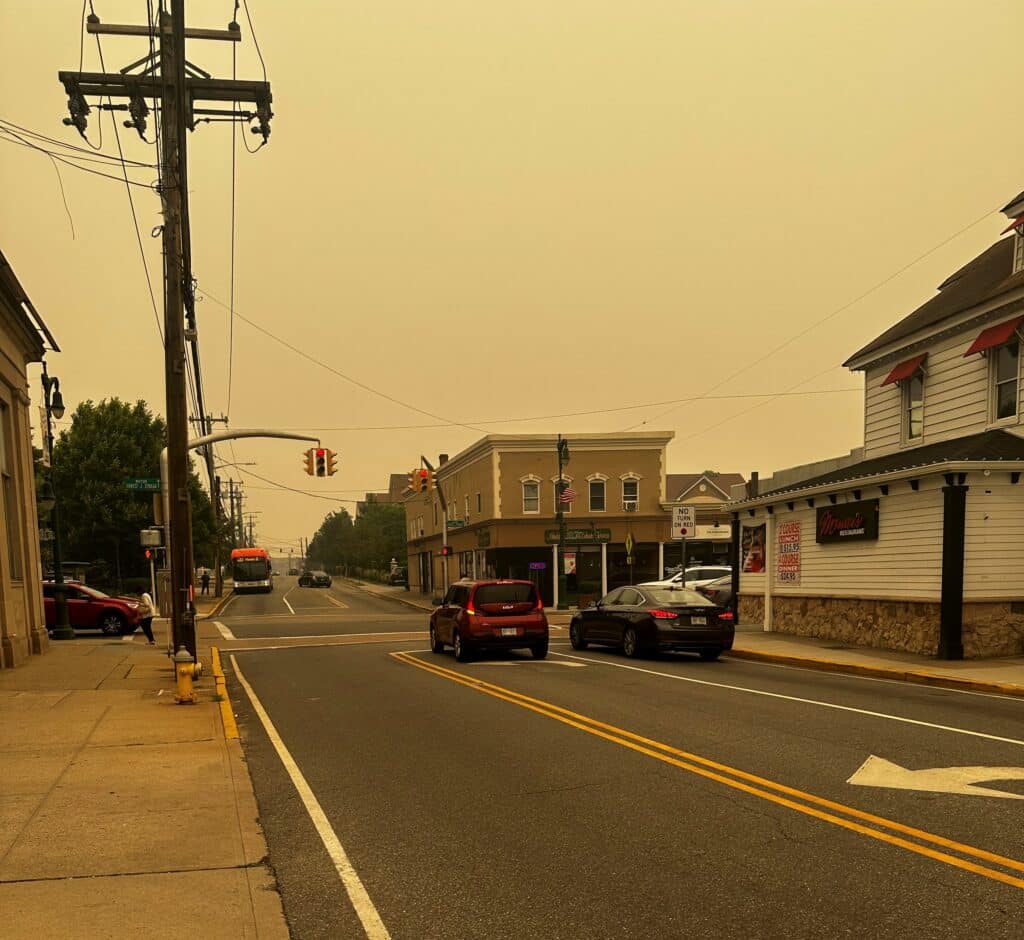By Janet Burns, Olivia Rainson and Matt Hellerman
From June 6 to 9, large swaths of the U.S. East Coast were blanketed in wildfire smoke originating in Eastern Canada, where climate change and related environmental factors (e.g. longer summers, shorter winters, less rain, and invasive bark-boring beetles, to name a few) have led to wildfires of increasing intensity and scope in recent years.
Seeing a red sun blotted out in a sky full of woodsmoke is not an uncommon occurrence on the West Coast of North America, where worsening wildfires have ravaged large parts of California, Oregon, Washington, and British Columbia in the past decade.
Here on the East Coast, however, the sight was shocking to many, as was the pervasive smell of woodsmoke and the irritation of particulate matter in our regional air. As a result, perhaps, reactions to the conditions were mixed and somewhat staggered among state and municipal authorities.
School districts and municipalities in lower New York State were mostly left to make their own decisions about the smoke, which is generally a difficult condition to predict, and moved into our area quickly on June 6 after weeks of ongoing fires in Canada.
For example, on June 7th, during the worst of the haze, Port Washington Superintendent Dr. Michael Hynes moved all after-school activities indoors and continued this precaution to the next day. However, most sports had already finished their seasons, so only a few activities remained.
“We prioritize the safety and well-being of our students and staff,” Dr. Hynes said in a letter to the community, where he promised to “continue to monitor the situation” closely.
Meanwhile, the majority of schools in that district cancelled their outdoor events entirely, and Port Youth Activities, which runs all throughout the summer, did the same. As the smoke gradually appeared to be behind (rather, above) us, after-school activities quickly re-opened to their fullest capacity, with administrators planning on finishing the school year without any more bumps in the road.

June 7 in Westbury.
On June 7, City of Glen Cove Mayor Pam Panzenbeck also posted on Facebook: “due to the diminished air quality, to protect the health and safety of our DPW workers and our parks’ employees, garbage will not be picked up tomorrow, Thursday, June 8. Tomorrow’s garbage and recycling will be picked up on Friday, June 9. If your usual pick up is Friday, this week, garbage and recycling will be picked up on Saturday, June 10. Pascucci Soccer Field and Maccarone Stadium will also be closed. All other city departments will be open.”
She cautioned residents against any outdoor activities.
Similarly, Town of Oyster Bay Supervisor Joseph Saladino posted on Facebook that “due to deteriorating air quality, there will be no sanitation or recycling collection tomorrow, Thursday, June 8th. Again, there will be no sanitation or recycling collection on Thursday due to air quality concerns and its impact on workers.”
One Westbury resident told Anton Media Group that, on June 7, he put on a mask and took his dog for a walk outside, where he encountered a USPS employee wearing a mask who was still delivering mail, as instructed, despite the strikingly poor air quality.
Over in New York City, all after-school activities were cancelled on June 7, and after a day or two of uncertainty, the Department of Education announced that all classes would be remote on Friday, June 9. One person who works for a private company on a line of boat tours for tourists told Anton Media Group that, on June 7, when visibility dropped severely in Manhattan and around NYC, boat operators simply refused to ‘sail’ during the worst of the smoke for safety reasons, despite what their bosses had told them.
In the subsequent days, news outlets reported a spike in breathing-related hospital visits in New York City for ailments such as asthma. The New York Times also reported that a substantial number of people were experiencing headaches or other ailments as a result of the smoke.
For her part, Governor Kathy Hochul called the yellowed skies that week “hard to miss.”
What should we know for next time?
While the early-June smoke that blanketed our region may have been the first such instance in recent memory, it won’t be the last.
Fire season continues through early October in most parts of North America, and numerous recent studies and climate models suggest that things are going to continue getting worse on this front.
With that in mind, Anton Media Group recently spoke to Dr. Kenneth Spaeth, Chief of Occupational and Environmental Medicine for Northwell Health, about the potential health effects of smoky skies in our area.
“I have not seen any definitive data on this. It usually takes a while to tabulate such things,” Spaeth noted. “I think the effects were certainly demonstrable, and, anecdotally, a lot of people were noting a burning sensation in their eyes and throat, even if it wasn’t enough to send them to get care.”
“Of course, there are people for whom heightened sensitivity and heightened vulnerability could be an issue, typically people who have underlying respiratory or cardiac issues, including some elderly populations.”
“During such high levels of air pollution and periods of poor air quality, those folks are certainly at higher risk for health events,” he explained. “But there’s not likely to be lingering consequences for most people. For those with underlying respiratory conditions that were triggered by the smoke, it may take them a little while to get back to their baseline.”
“Of course, there are long-term consequences for exposure chronically to air pollution,” Spaeth continued. “Meaning, living for extended periods in settings where there’s air pollution has been shown to have a variety of chronic effects. The longer term issues are more a consequence of chronic, persistent exposure over extended periods, such as years.”
When asked whether masking up can keep us safe from smoke outdoors, Spaeth commented, “I wouldn’t say it does nothing, but it’s not full protection. Even with an N95 mask that has a proper fit, many of the contaminants in the air for the past few weeks are small enough that they could go through the mask. So, it’s worth wearing something to try to reduce the exposure, but it’s good to remember that it’s not enough.”
Dr. Spaeth also emphasized, “As long as those wild fires are burning, it’s useful to pay attention to what the air levels and the air quality are because the extent to which our area is affected is really going to be at a function of the weather and meteorological conditions. Those, as we all know, can change pretty quickly.
“There’s some good resources, like airnow.gov, where you can check real-time levels in the Long Island and New York City areas just to keep an eye on it. And if the levels start to get into the orange and red zones, then depending on someone’s health status and how high the levels are, it may be worth trying to stay indoors more and avoiding exercising or exertion outside.”

































